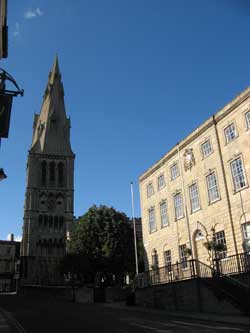Council business had been carried on since the Middle Ages in a room over the gateway on the bridge; when this started causing traffic problems, agreement was reached with the Turnpike Trustees to rebuild on the current site. The Cecil family part funded the building, which was completed in 1779.
The original designer may have been a cabinet maker called Henry Tatam, as there are similarities between this building and his own house in Barn Hill. The northern elevation, around the corner to the left as you view the front, is almost identical to this one, giving a symmetrical look to the building. If you look up between the top tier of windows, you can see a cartouche on which are the arms of Stamford.
The Town Hall has changed over the years, including the remodelling of the entrance hall in the early nineteenth century and the addition of the Council Chamber in the early twentieth century. The external terrace and stairs are an addition from about 1952. A major renovation programme, including the provision of a lift, was still ongoing in 2013.
The Mayor’s parlour houses the Town’s charters, civic plate and regalia, some of which date back to the 15th century. Other rooms include the Court Room, used as a Magistrates’ Court until about 2010 but now largely used for civic receptions, the Phillips Room which is named after a former mayor and local brewer and holds the Town’s library and the Malcolm Sargent Room, which houses a significant collection of artefacts relating to Sir Malcolm, who lived in Stamford for many years, and presented to Stamford Town Council by his family.
In addition, the building houses an impressive collection of pictures, and furniture. After the closure of the town museum in 2010, many of the Stamford artefacts loaned to the Museum by Stamford Town Council were returned for display.
Tours of the town hall are run, free of charge, on Fridays.
